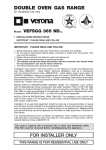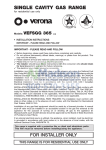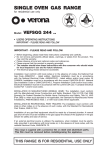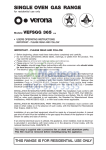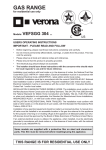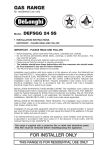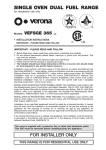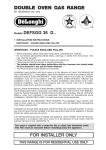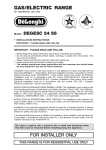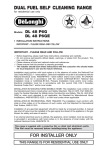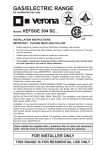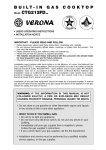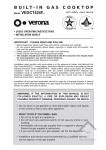Download Verona VEFSGG 244 Instruction manual
Transcript
SINGLE OVEN GAS RANGE for residential use only Model: VEFSGG 244 .. • INSTALLATION INSTRUCTIONS IMPORTANT - PLEASE READ AND FOLLOW IMPORTANT - PLEASE READ AND FOLLOW ✓ Before beginning, please read these instructions completely and carefully. ✓ Do not remove permanently affixed labels, warnings, or plates from the product. This may void the warranty. ✓ Please observe all local and national codes and ordinances. ✓ Please ensure that this product is properly grounded. ✓ The installer should leave these instructions with the consumer who should retain for local inspector's use and for future reference. ✓ The electrical plug should always be accessible. Installation must conform with local codes or in the absence of codes, the National Fuel Gas Code ANSIZ223.1 - Iatest edition. Electrical installation must be in accordance with the National Electrical Code, ANSI/NFPA70 - latest edition and/or local codes. IN CANADA: Installation must be in accordance with the current CAN/CGA-B149.1 National Gas Installation Code or CAN/CGA-B149.2, Propane Installation Code and/or local codes. Electrical installation must be in accordance with the current CSA C22.1 Canadian Electrical Codes Part 1 and/or local codes. INSTALLATION IN MANUFACTURED (MOBILE) HOME: The installation must conform with the Manufactured Home Construction and Safety Standard, Title 24 CFR, Part 3280 [formerly the Federal Standard for Mobile Home Construction and Safety, Title 24, HUD (Part 280)] or, when such standard is not applicable, the Standard for Manufactured Home Installations, ANSI/NCSBCS A225.1, or with local codes where applicable. INSTALLATION IN RECREATIONAL PARK TRAILERS: The installation must conform with state or other codes or, in the absence of such codes, with the Standard for Recreational Park Trailers, ANSI A119.5. Installation of any gas-fired equipment should be made by a Iicensed plumber. A manual shut-off valve must be installed in an accessible location in the gas line external to the appliance for the purpose of turning on or shutting off gas to the appliance (In Massachusetts such shutoff devices should be approved by the Board of State Examiners of Plumbers & Gas Fitters). If an external electrical source is utilized, the appliance, when installed, must be electrically grounded in accordance with local codes or, in the absence of local codes, with the national Electrical Code, ANSI/NFPA 70. This range is supplied with a protective film on steel and aluminium parts. This film must be removed before installing/using the appliance. FOR INSTALLER ONLY THIS RANGE IS FOR RESIDENTIAL USE ONLY WARNING • ALL RANGES CAN TIP • INJURY TO PERSON COULD RESULT • INSTALL ANTI-TIP DEVICE PACKED WITH RANGE • SEE INSTALLATION INSTRUCTIONS WARNING: IF THE INFORMATION IN THIS MANUAL IS NOT FOLLOWED EXACTLY, A FIRE OR EXPLOSION MAY RESULT CAUSING PROPERTY DAMAGE, PERSONAL INJURY, OR DEATH. ✓Do not store or use gasoline or other flammable vapors and liquids in the vicinity of this or any other appliance. ✓WHAT TO DO IF YOU SMELL GAS: • Do not try to light any appliance. • Do not touch any electrical switch; do not use any phone in your building. • lmmediately call your gas supplier from a neighbor's phone. Follow the gas supplier's instructions. • lf you cannot reach your gas supplier, call the fire department. ✓Installation and service must be performed by a qualified installer, service agency, or the gas supplier. 2 DATA PLATE CONVERSION LABEL This appliance is designed and manufactured solely for the cooking of domestic (household) food and in not suitable for any none domestic application and therefore should not be used in a commercial environmement. The appliance guarantee will be void if the appliance is used within a none domestic environnement i.e. a semi commercial, commercial or communal environment. 3 INSTALLATION INSTRUCTIONS WARNING! THIS APPLIANCE HAS TO BE INSTALLED BY A QUALIFIED INSTALLER. Improper installation, adjustment, alteration, services, or maintenance can cause injury or property damage. Consult a qualified installer, service agent, or the gas supplier. IMPORTANT: The use of suitable protective clothing/gloves is recommended when handling, installing of this appliance. TOOLS NEEDED FOR INSTALLATION (NOT SUPPLIED WITH THE APPLIANCE) 4 Screwdriver 2 - Wrench Suitable protective gloves Hammer T-handle wrench Pencil Adjustable wrench Adjustable pliers Tape measure Drill GENERAL INFORMATION 1.Installation must conform with local codes or, in the absence of local codes, with the National Fuel Gas Code, ANSI Z223.1-Latest Edition. 2.Installation in manufactured (mobile) home: installation must conform with the Manufactured Home Construction and Safety Standard, Title 24 CFR, Part 3280 [formerly the Federal Standard for Mobile Home Construction and Safety, Title 24, HUD (Part 280)] or, when such standard is not applicable, the Standard for Manufactured Home Installations, ANSI/NCSBCS A225.1, or with local codes where applicable. 3.Installation in Recreational Park Trailers: installation must conforms with state or other codes or, in the absence of such codes, with the Standard for Recreational Park Trailers, ANSI A119.5. 4. WARNING!! WARNING!! ELECTRICAL GROUNDING INSTRUCTIONS The range must be electrically grounded in accordance with local codes or, in the absence of local codes, with the National Electrical Code, ANSI/NFPA No. 70-latest edition. Installation should be made by a Iicensed electrician. FOR PERSONAL SAFETY, THIS APPLIANCE MUST BE PROPERLY GROUNDED. If an external electrical source is utilized, the installation must be electrically grounded in accordance with local codes or, in the absence of local codes, with the national Electrical Code, ANSI/NFPA 70. This appliance shall not be used for space heating. This information is based on safety considerations. This appliance is equipped with a three-prong grounding plug for your protection against shock hazard and should be plugged directly into a properly grounded socket. 5.AlI openings in the wall behind the appliance and in the floor under the appliance shall be sealed. Do not under any circumstances cut or remove the third (ground) prong from the power plug. 6.Keep appliance area clear and free from combustible materials, gasoline, and other flammable vapors. 7.Do not obstruct the flow of combustion and ventilation air. REPLACEMENT PARTS 8.Disconnect the electrical supply to the appliance before servicing. Only authorized replacement parts may be used in performing service on the range. Replacement parts are available from factory authorized parts distributors. Contact the nearest parts distributor in your area. 9.When removing appliance for cleaning and/or service; A. Shut off gas at main supply. B. Disconnect AC power supply. C. Disconnect gas line to the inlet pipe. D. Carefully remove the range by pulling outward. CAUTION: Range is heavy; use care in handling. 10. Electrical Requirement Electrical installation should comply with national and local codes. 11. Air Supply and Ventilation The installer must refers to local/national codes. 12. Gas Manifold Pressure Natural gas - 4.0” W.C.P. LP/Propane - 11.0” W.C.P. 13. The misuse of oven door (e.g. stepping, sitting, or leaning on them) can result in potential hazards and/or injuries. 14. When installing or removing the range for service, a rolling lift jack should be used. Do not push against any of the edges of the range in an attempt to slide it into or out of the installation. Pushing or pulling a range (rather than using a lift jack) also increases the possibility of bending the leg spindles or the internal coupling connectors. 5 installation MIN 35" 7/16 (900 mm) (113 mm) PROXIMITY TO SIDE CABINETS 1. This range may be installed directly adjacent to existing 36" (914 mm) high base cabinets. Range dimensions: • width: 23” 7/8 (606.5 mm) • depth: 24” 5/64 (611.6 mm) MAX 36" 7/32 (920 mm) 4" 7/16 • height (without backguard): MIN 35” 7/16 (900 mm) - MAX 36” 7/32 (920 mm) • backguard (height): 4” 7/16 (113 mm) Gas line opening: Wall - 5” 57/64 (150 mm) from the floor; 11” 15/16 (303 mm) from the rear left side of the range. Grounded outlet: the electric cord with 3-prong ground plug has a length of 72” (1830 mm). Grounded outlet should be located 5” 57/64 (150 mm) from the floor and 11” 15/16 (303 mm) from the rear right side of the range. 2. The range CANNOT be installed directly adjacent to sidewalls, tall cabinets, tall appliances, or other side vertical surfaces above 36” (914 mm) high. 2 (61 4" 5 1.6 /64 m m ) Fig. 1.1 7/8 23" m) .5 m (606 There must be a minimum of 3” (76 mm) side clearance from the range to such combustible surfaces TO THE LEFT above the 36” (914 mm) high countertop; or there must be a minimum of 11” 13/16 (300 mm) side clearance from the range to such combustible surfaces TO THE RIGHT above the 36” (914 mm) high countertop. IMPORTANT: One side (left or right) above the 36” (914 mm) high countertop must always be kept clear. 3. The maximum upper cabinet depth recommended is 13” (330 mm). Wall cabinet above the range must be a minimum of 30” (762 mm) above the countertop for a width of minimum 24” (609.6 mm): it has to be centred with the range. Side wall cabinets above the range must be a minimum of 18” (457 mm) above the countertop. GAS AND ELECTRIC CONNECTION Dotted line showing the position of the range when installed Area for GAS connection 11" 15/16 (303 mm) 5" 57/64 (150 mm) (303 mm) Area for ELECTRICAL connection 11" 15/16 6 Fig. 1.2 PROXIMITY TO SIDE CABINETS min. (300 mm) 3" min. (7 18" min. (457 mm) 11" 13/16 6 mm) mm) 30" min. (762 mm) 13" max. (330 mm) 18" min. (457 mm) 30" min. (762 mm) 13" max. (330 20" min m) . (500 m . (500 m 0" m) (0 m 0" Fig. 1.3a (0 m) 36" (914 mm) 36" (914 mm) 20" min 0" (0 mm ) 0" (0 mm mm) Fig. 1.3b ) A A NT N VE OVE B Fig. 1.4 ASSEMBLING THE BACKGUARD It is mandatory to install the backguard Assemble the backguard as shown in figure 1.5: • Screw the 2 screws “A” interposing the spacers. • Screw the central screw “B”. Fig. 1.5 7 LEVELLING THE RANGE The range is equipped with 4 levelling feet and may be levelled by screwing or unscrewing the feet with a spanner (fig. 1.8). It is important to observe the directions of figures 1.6, 1.7a, 1.7b. Fig. 1.6 Supplied with the range in a separate kit 0 mm 0" + 8 mm + 5/16" + 8 mm + 5/16" Fig. 1.7a YOU MUST USE STABILITY ANTI TIP BRACKET TO PREVENT UNIT FROM TIPPING. + 20 mm + 25/32" Fig. 1.7b Fig. 1.8 ANTI-TIP STABILITY DEVICE INSTALLATION INSTRUCTIONS 1. The anti-tip bracket has to be attached as shown on figure below (only rear right side), it has to be fixed on the floor and on the rear wall by no. 4 (four) suitable screws (not supplied). 2. After fixing the anti-tip bracket, slide range into place. Be sure the rear right foot slides under the anti-tip bracket attached. Dotted line showing the position of the range when installed = ANTI-TIP STABILITY DEVICE FIXING = 10" 15 /64 (260 m m) Anti-tip stability device Rear right feet of range Fig. 1.9 8 gas connection All gas connections must be made according to national and local codes. This gas supply (service) line must be the same size or greater than the inlet line of the appliance. Sealant on all pipe joints must be resistant to te action of LP/Propane gas. The range is equipped for the use with NATURAL gas. It is design-certified by CSA International for NATURAL and L.P. gases with appropriate conversion. The model/serial rating plate, located inside the drawer, has information on the type of gas that can be used. If this information does not agree with the type of gas available, check with the local gas supplier. See page from 13 to 16 for L.P. gas conversion instructions. 1. Manual Shut-off Valve (fig: 2.1): A manual shut-off valve must be installed in an accessible location in the gas line external to the appliance for the purpose of turning on or shutting off gas to the appliance (In Massachusetts such shutoff devices should be approved by the Board of State Examiners of Plumbers & Gas Fitters). This valve should be located in the same room as the range and should be in a location that allows ease of opening and closing (in a position where it can be reached quickly in the event of an emergency). Do not block access to the shutoff valve. The valve is for turning on or shutting off gas to the appliance. Explosion Hazard Use a new CSA or UL approved gas supply line. Install a shut-off valve. Securely tighten all gas connections. If connected to LP, have a qualified person make sure gas pressure does not exceed 14" water column. Examples of a qualified person include licensed heating personnel, authorized gas company personnel, and authorized service personnel. Shutoff valve “open” position Failure to do so can result in death, explosion, or fire. To range Gas supply line Fig. 2.1 2. Pressure Regulator: a) All heavy duty, commercial type cooking equipment must have a pressure regulator on the incoming service line for safe and efficient operation, since service pressure may fluctuate with local demand. Before installing the regulator mount the 1/2” NPT (conical) male connector to the regulator (see picture 2.2). Gasket supplied have to be placed between 1/2” NPT (conical) connector/extension pipe male pipe fitting (see picture 2.3). The regulator supplied with this range must be installed before any gas connections are made. Use supplied pressure regulator only. 9 PRESSURE REGULATOR INSTALLATION STEP 1 Mount the 1/2” NPT (conical) male connector to the pressure regulator and tighten by using a wrench. Do not over tighten the connector. Over tightening may crack regulator. LOCK Arrow Fig. 2.2 STEP 2 Assemble the 1/2” NPT connector + pressure regulator group to the extension pipe interposing the gasket supplied. The regulator cover must be oriented toward the front side of the range. IMPORTANT: use two spanners to tighten the connection. Regulator cover 10 Fig. 2.3 GAS CONNECTION SPECIFICATION Range manifold Manifold male pipe fitting 1/2” G cylindrical (ISO 228-1) male Gasket 1/2” G cylindrical (ISO 228-1) female To range Extension Extension pipe female pipe pipe fitting fitting Extension pipe Extension pipe male pipe fitting Gasket 1/2” NPT (conical) male 1/2” G cylindrical (ISO 228-1) male Manifold test point pressure 1/8” NPT 1/2” G cylindrical (ISO 228-1) female Connector 1/2” NPT female To mains connection Pressure regulator 1/2” NPT female Arrow WARNING: check the right positioning of the gas regulator. The arrow on the back of the gas regulator must be oriented toward the connector. Fig. 2.4 11 b) Any conversion required must be performed by your dealer or a qualified licensed plumber or gas service company. Please provide the service person with this manual before work is started on the range. (Gas conversions are the responsibility of the dealer or end user.) To range c) This range can be used with NATURAL or LP/PROPANE gas. It is shipped from the factory adjusted for use with NATURAL gas. Manifold test point pressure 1/8” NPT To mains connection d) Manifold pressure should be checked with a manometer; NATURAL gas requires 4.0” W.C.P. and LP/PROPANE requires 11.0” W.C.P. (see side figure). Incoming line pressure upstream from the regulator must be 1” W.C.P. higher than the manifold pressure in order to check the regulator. The regulator used on this range can withstand a maximum input pressure of 1/2 PSI (14.0” W.C.P). If the line pressure is in excess of that amount, a step-down regulator will be required. e) The appliance, its individual shut-off valve, and pressure regulator must be disconnected from the gas supply piping system during any pressure testing of that system at pressures in excess of 1/2 PSI (3.5 kPa). f) The appliance must be isolated from the gas supply piping system by closing its individual manual shut-off valve during any pressure testing of the gas supply piping system at test pressure equal to or less than 1/2 PSI (3.5 kPa). Screw 3. Flexible Connections: If local codes permit, CSA design-certified, flexible metal appliance connector is recommended for connecting this range to the gas supply line. Do Not kink or damage the flexible connector when moving the range. The pressure regulator has 1/2" NPT female pipe threads.You will need to determine the fittings required, depending on the size of your gas supply line, flexible metal connector and shutoff valve. Unscrew Fig. 2.5 4. Rigid Pipe Connections: If rigid pipe is used as a gas supply line, a combination of pipe fittings must be used to obtain an in-line connection to the range. All strains must be removed from the supply and fuel lines so range will be level and in line. • Use joint compounds and gaskets that propane gas on all male pipe threads. are resistant to action of natural or • Do not over tighten gas fitting when attaching to pressure regulator. Over tightening may crack regulator. 5. Leak Testing: IMPORTANT: Leak testing of the appliance shall be conducted as follows: • After final gas connection is made, turn on manual gas valve and test all connections in gas supply piping and appliance for gas leaks with a soapy water solution. During this test all appliance gas valves have to be closed. • In order to avoid property damage or serious personal injury, never use a Iighted match. If a leak is present, tighten joint or unscrew, apply more joint compound, tighten again and retest connection for leak. 12 CONVERSION tO LP/PROPANE GAS Every range is provided with a set of injectors for the various types of gas. Select the injectors to be replaced according to the “INJECTORS TABLE”. The nozzle diameters, expressed in hundredths of a millimetre, are marked on the body of each injector. SETTING THE PRESSURE REGULATOR (fig. 2.6b) The pressure regulator is accessible by removing the bottom drawer; the pressure regulator is positioned on the rear left side of the range. To remove the drawer proceed as per figure 2.6a. To set the pressure regulator: 1. Unscrew the regulator cover; 2. Unscrew the A component, reverse and screw it according to the LP/PROPANE regulation. Pressure regulator 1 2 3 4 REGULATOR COVER Fig. 2.6a Fig. 2.6b 13 INJECTORS TABLE J NOMINAL POWER REDUCED POWER LP/PROPANE 11" W.C.P. NATURAL GAS 4" W.C.P. BTU/hr BTU/hr Ø injector [1/100 mm] Ø injector [1/100 mm] Auxiliary (AUX) 3500 1000 55 90 Semirapid (SR) 6000 1500 72 118 Triple ring (TC) 12000 5000 102 170 Oven burner 13000 1500 109 180 Broil burner 8500 - 88 146 BURNERS Fig. 2.7 OPERATIONS TO BE PERFORMED WHEN SUBSTITUTING THE INJECTORS ✓Remove the gratings, the burner covers and the knobs; J ✓Using a wrench substitute the nozzle injectors “J” (figs. 2.7 - 2.8) with those most suitable for the kind of gas for which it is to be used. The burner are conceived in such a way so as not to require the regulation of the primary air. Fig. 2.8 SETTING THE BURNER MINIMUM When switching from one type of gas to another, the minimum flow rate must also be correct: the flame should not go out even when passing suddenly from maximum to minimum flame. To regulate the flame follow the instructions below: F – Light the burner – Set the gas valve to position – Remove the knob – With a thin screwdriver turn the screw F until adjustment is correct (fig. 2.9). Fig. 2.9 For LP/PROPANE gas, tighten the adjustment screws completely. 14 OPERATIONS TO BE EXECUTED FOR THE REPLACEMENT OF THE INJECTORS OF THE OVEN AND BROIL BURNERS a) Oven Burner – Lift and remove the lower panel inside the oven. – Remove the burner securing screw (fig. 2.10). – Withdraw the burner as shown in figure 2.11 and rest it inside the oven. Take care not to damage the wire to the ignition electrode and the safety valve probe. – Using a 7 mm box spanner, unscrew the injector (indicated by the arrow in fig. 2.11) and replace it by the proper one according to the kind of gas. Then replace the burner repeating the above steps in reverse order. Fig. 2.10 b) Broil Burner – Remove the burner by unscrewing the front screw (fig. 2.12). Gently suspend the burner as shown in figure 2.13. Be careful not to damage the wire of the electric ignition and the probe of the safety valve. – Using a 7 mm box spanner, replace the injector (indicated by the arrow in fig. 2.13) by the proper one according to the kind of gas. – Replace the burner repeating the above steps in reverse order. Fig. 2.11 Fig. 2.12 Fig. 2.13 15 G ADJUSTMENT OF THE OVEN BURNER MINIMUM This needs to be done only for the oven burner (the broil is a fixed capacity) by acting on the thermostat in the following way: – Turn on the burner by setting the thermostat knob on position . – Remove the knob and unscrew the by-pass screw "G" (fig. 2.14) about three times by passing a small flat screwdriver (Ø 3 mm blade, 100 mm length) through the panel opening. – Re-mount the knob and let the oven heat up for about 10 minutes, then bring the knob to position (minimum) to operate the thermostat by-pass. Fig. 2.14 – After having removed the knob again and being very careful not to turn the tap rod, slowly screw the by-pass screws “G” (fig. 2.14) until you obtain a flame of 3-4 mm in height. N.B. For LP/PROPANE gas the by-pass screw must be fixed thoroughly. After regulation repeat the operations indicated in paragraph “2. Pressure regulator” at page 9. If the range has been disconnected and then connected again to the gas supply line repeat the operations indicated in paragraph “5. Leak Testing” at page 12. IMPORTANT: After conversion to LP/PROPANE gas has been carried out affix inside the drawer, near the data plate, the conversion label supplied and also affix a conversion label at page 3 of this instruction manual. 16 electrical connection If codes permit and a separate ground wire is used, it is recommended that a qualified electrician determine that the ground path is adequate. Check with a qualified electrician if you are not sure whether the range is properly grounded. Do Not ground to a gas pipe. WARNING A 120-volt, 60-Hz, AC-only, 15-ampere, fused electrical supply is required. A time-delay fuse or circuit breaker is recommended. It is recommended that a separate circuit serving only this appliance be provided. The outlet must be checked by a qualified electrician to see if it is wired with correct polarity. This appliance, when installed, must be electrically grounded in accordance with local codes. Recommended ground method Electrical Shock Hazard Plug into a grounded 3-prong outlet. Do not remove ground prong. Do not use an adapter. Failure to follow these instructions can result in death, fire, or electrical shock. For your personal safety, this range must be grounded. This range is equipped with a 3-prong ground plug. To minimize possible shock hazard, the cord must be plugged into a mating 3-prong ground-type outlet, grounded in accordance with the National Electrical Code ANSI/NFPA 70 latest edition and local codes and ordinances. If a mating outlet is not available, it is the personal responsibility and obligation of the customer to have a properly polarized and grounded, 3-prong outlet installed by a qualified electrician. WARNING VERY IMPORTANT 3-prong polarized ground-type outlet 3-prong ground plug Before any operation of maintenance disconnect the appliance from the electrical mains supply. power supply cord ground prong Fig. 3.1 17 WIRING DIAGRAM Fig. 3.2 18 19 The manufacturer cannot be held responsible for possible inaccuracies due to printing or transcription errors in the present booklet. The manufacturer reserves the right to make all modifications to its products deemed necessary for manufacture or commercial reasons at any moment and without prior notice, without jeopardising the essential functional and safety characteristics of the appliances. Cod. 1103635 - ß1




















